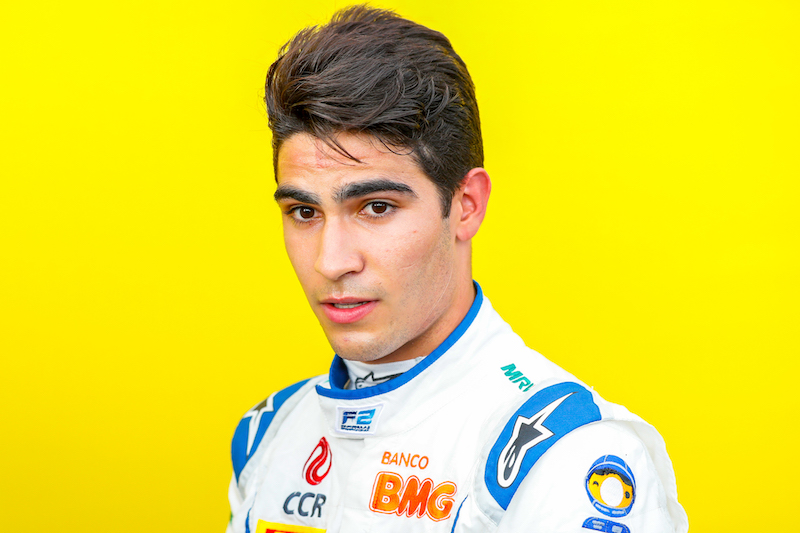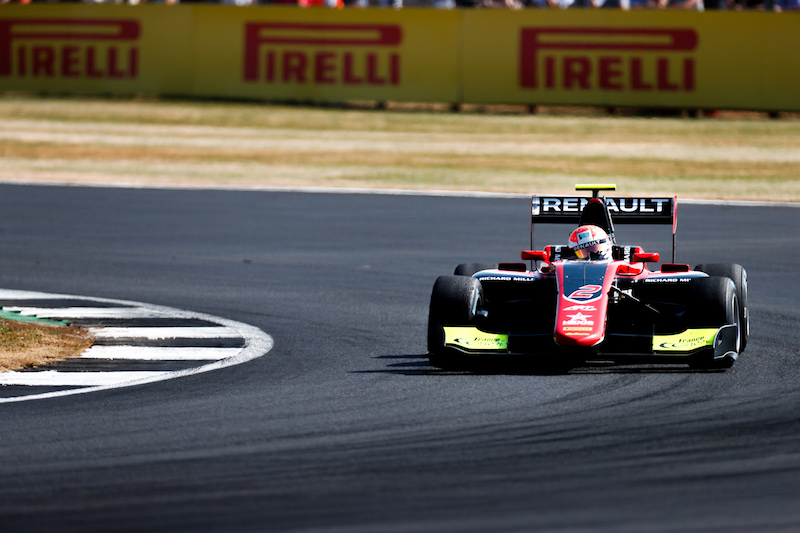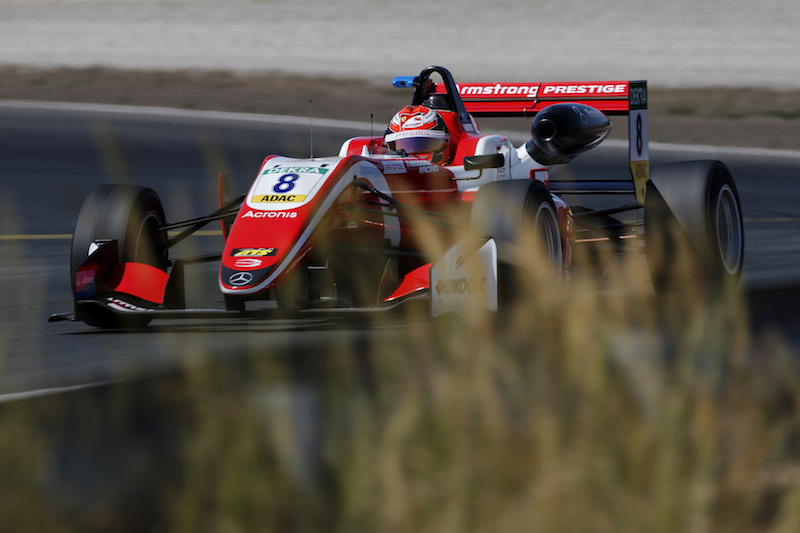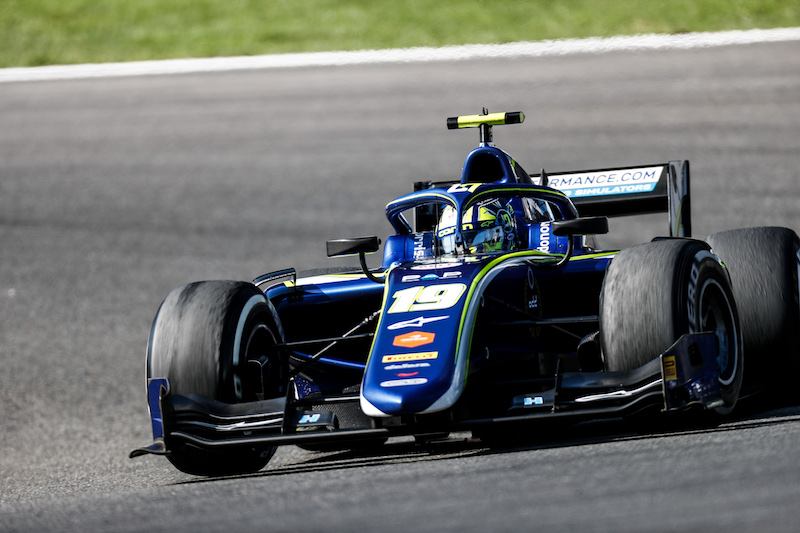Find out who the Formula Scout team ranked as the top 10 junior single-seater drivers of the 2018 season
10. Sergio Sette Camara
Up 35
Showed well alongside Norris in F2 to clinch a McLaren role
Sette Camara has long shown potential, but 2018 was the year where it became obvious to a wider audience. He lacked the experience or the machinery to run at the front as a Formula 2 rookie in 2017, but the reset offered by the new car and a Carlin seat next to Lando Norris now provided him with that opportunity.
Norris was complementary to his team-mate from very early on, something that would eventually help Sette Camara to succeed the Briton as McLaren’s test driver for next season. His inspired fightback against the charging Artem Markelov secured Carlin a one-two in the opening race in Bahrain, but neither driver would win again.
Nevertheless, Sette Camara may still have been an outside factor in the title fight but for a rotten run of misfortune early on: disqualification from a Baku podium due to a lack of fuel, technical issues in Barcelona and a hand injury that ruled him out of the Monaco races after a qualifying crash.
Second place on his return in the Paul Ricard feature race, where he chased down George Russell, was impressive, as were a similar result at Spa and his Hungaroring pole.
His superior qualifying record to Norris is perhaps the standout feat of his year, and to dismiss him as being more experienced is not entirely fair or accurate.
Sette Camara has decided to take Alex Albon’s place at DAMS next year, and must aim to at least replicate his predecessor with a title challenge and a season that proves him worthy of an F1 drive.
- Who will be Brazil?s next Formula 1 driver? (November 11)
9. Anthoine Hubert
Up 15
Claimed final GP3 title with classy and consistent campaign
Hubert showed plenty of class on his way to becoming the final ever GP3 champion. His two second places set the tone for a consistent campaign not hugely unlike that of his fellow Frenchman Esteban Ocon.
Historically, being in a second season in GP3 has offered very little advantage over those arriving from European Formula 3. Hubert is only the second non-rookie to win a GP3 title in nine years, after Mitch Evans’ narrow triumph over Daniel Abt. It certainly didn’t give Hubert much of a benefit in raw speed, but he is now a wise and experienced driver in general terms and he used that to maximum effect.
He might not have been outright fastest frequently – with only two poles and two wins, one of which was inherited later – but Hubert was quick more consistently than anybody, with the best qualifying average. He was intelligent and effective in races, making great progress (particularly in reversed-grid races) while avoiding incident.
The only costly mistake was his wide moment in Red Bull Ring qualifying that filled his car with grass and caused it to shut down. It was a hit from team-mate Nikita Mazepin that meant he scored nothing rather than recovering a pair of good results. He?showed great resolve to bounce back and dominate at Silverstone on rival Callum Ilott’s home patch.
Winning the title delivered on the expectations of the Renault Sport Academy, which will almost certainly ensure that Hubert can make a deserved step up to F2 in 2019.
- Ranking the stars of the final GP3 season (December 22)
8. Christian Lundgaard
Up 28
Renault protege came agonisingly close to Eurocup title as a rookie
He might have won two F4 titles in his first season out of karts last year, but Lundgaard exceeded all expectations by almost winning the Formula Renault Eurocup – usually a difficult series for rookies to get to grips with.
What made Lundgaard’s season all the more impressive was that it came with an outsider team in MP Motorsport, which had struggled on its Eurocup return in 2017. Lundgaard put the Dutch squad’s progress down to the experience of his team-mates Max Defourny and Alex Peroni, but he was almost always a cut above them on track. R-ace GP meanwhile had four multiple race-winners.
It’s also fair to say that Lundgaard was unlucky to ultimately lose the championship.
A win at Monza had put the Dane top of the standings early on, and he then remained close to the consistent Yifei Ye over the following four rounds. At the Hungaroring at the start of September, a poor start from pole cost him victory to his rival in race one, but he bounced back perfectly with victory in race two to end the weekend on top.
He took a 13.5-point lead over fellow Renault junior Max Fewtrell to the penultimate round at Hockenheim, but retired from the opening race after a failure induced by first-lap contact. He rallied again to take race two pole, and was holding Fewtrell off when a driveshaft broke.
A first and a second at Barcelona wasn’t enough to beat Fewtrell to the title, but it did reinforce his strong performance. He’ll look to make a similar impression in FIA F3 next year, probably driving for ART.
7. Mick Schumacher
Re-entry (23rd in ’16)
Snatched European F3 title with late-season streak
Schumacher’s European F3 title success divides opinion, and that’s a shame because the 19-year-old undoubtedly deserves credit for being able to perform to a high level in difficult family circumstances.
Even so, there is no getting away from the fact that Schumacher was disappointing during the early part of the season. Over the first four rounds he was no match for three of his Prema team-mates, and managed no better than two third-places in that period.?The breakthrough win then came at Spa, aided by an improvement in qualifying, an area in which he had always struggled previously. That was followed by further victories at Silverstone and Misano that allowed him to creep into championship contention.
Then came the three wins at the Nurburgring and two at the Red Bull Ring:?a run of form that nobody else got close to achieving all year in such a close and competitive field. As such, it enabled him to leap into a decisive championship lead. Such a huge improvement in the middle of a driver’s second season raised the suspicions of seasoned observers, even before the frustrations of his rivals and team-mates surfaced.
Allegations of an engine power advantage, legal or not, will probably never be proven one way or the other. Regardless of what was behind it, two dominant weekends are not enough on their own to make a driver the standout talent in any series, even if the points table says otherwise. A lacklustre run at the Macau Grand Prix did nothing to disprove that sentiment.
At the very least though, Schumacher did display some improvement in himself and plenty of the family traits, and made many excited about what he could go on to achieve. How he now fares in F2 will indicate whether he can live up to the hype.
6. Marcus Armstrong
Up 7
Ferrari junior led European F3 title race after step up from F4
Plenty of anticipation surrounded Armstrong’s move into F3 and he quickly delivered.
The step from F4 to European F3 has traditionally been a big one, although Armstrong did have some experience in Formula Renault and the Toyota Racing Series in his native New Zealand, where his car shutting down into safe mode on the final lap cost him the 2018 title.
For his first F3 races he was in at the deep end in Pau, his first experience of a street circuit, but he coped admirably to score a podium. A second place followed at the Hungaroring, and could have been in a better position had he not come off worse from contact with Dan Ticktum in three of the first six races.
A maiden pole and win and two other podiums at the Norisring put Armstrong into the points lead, and the impressively mature Kiwi declared he would be prioritising points for the championship over individual race results.
This approach served him well for a while, but a spate of incidents in the middle of the season, not all his fault, cost him, and he was unable to match the improved form of Schumacher and Robert Shwartzman late on. Three further retirements in a torrid final round took his tally of non-finishes to a rather surprising nine, and left him fifth in the final standings.
Lots of promise was shown however in his first season at continental level, and he heads to the new FIA F3 series with Prema in 2019 as a title favourite.
5. Juri Vips
Up 20
F3 rookie shone to win Red Bull’s backing
Vips’ run to the ADAC F4 title in 2017 had appeared solid but unspectacular, nothing special, and that was reflected by his position in this list.
In European F3 in 2018, he was a completely different beast. Spectacular he definitely was. Too spectacular for Pau’s tight confines. But two rounds later at the Norisring, he starred, winning one race and coming very close (within 0.57 seconds, in fact) in another.
Further victories from pole at Silverstone and Misano (the latter after a stunning wet qualifying performance) brought him into championship contention, though he dropped away again almost as quickly after a torrid Nurburgring weekend. He was a winner once more at Hockenheim, 12 months on from his F3 debut, and would have had third in the championship had he not been turned around on the first lap of the finale.
Vips and Motopark seemed a great fit, and although budget constraints caused him to miss out on testing at the end of 2017, the 18-year-old Estonian gradually became the team’s strongest performer ahead of Dan Ticktum, particularly in qualifying.
It was therefore pretty natural that he was picked up by Red Bull – he’s exactly the type of driver the firm should be backing – to ease those funding fears. Vips had to announce that news in tandem with the passing of his father just days before the Macau Grand Prix, but he went on to show great speed on his first time there, even if he was lacking in luck. It will be fascinating to see how he gets on in FIA F3 in 2019 with Hitech.
- Estonia: The underdog that keeps on achieving?(November 13)
4. Dan Ticktum
Up 14
Red Bull junior monstered Macau after European defeat
Ticktum was in the hunt for the European F3 title from start to finish, and although he ended up succumbing to the Schumacher surge, his ability was on show plenty of times in the process.
After getting off the mark from pole at the Hungaroring, his three other victories across the subsequent four rounds were all spectacular: returning from hospital at the Norisring to hold off Vips in a rebuilt car, working his way up from 10th at Spa, and finding a way past Sacha Fenestraz at Silverstone.
Given those great drives, it’s a shame that Ticktum failed to make anything out of three of his four poles in the first four rounds. In the second half of the season, he shook off that inconsistency – he scored in every race bar one – but lost his speed: After his Silverstone win, his best results were a pair of thirds (mirroring Schumacher’s start to the year), and he seemed to let the situation affect his performances, however understandable his concerns might have been.
He couldn’t have bounced back from that disappointment in better style with a dominance of the Macau Grand Prix that has rarely ever been seen. He was always confident in his ability around the Guia circuit and it showed, contributing to, and making the most of, Motopark’s commanding performance.
Ticktum did make mistakes this year. But do we want F3 drivers to be perfect, or to wow us with their talent on their good days? Of course what the errors did show was that, regardless of his superlicence situation, he’s not yet ready for F1 – at least not if he’s to get the most out of his talent, anyway. For Red Bull to talk up his F1 prospects mid-season was probably misguided. Or was a deliberate test? Either way, a gap year in Japan could be just what he needs to grow in maturity, even if it does deprive F2 viewers of his talent.
- Why Red Bull was the big winner in Macau (November 19)
3. Lando Norris
Down 1
Rookie fought for F2 title and landed McLaren promotion
Norris was massively hyped-up coming into F2, yet he lived up to that and more when he dominated the first race in Bahrain. It made him the youngest ever winner at that level, breaking Fernando Alonso’s record.
What followed – the failure to win another race – was remarkable and naturally disappointing. The always self-critical Norris labelled it his worst season so far, but he probably learned more than ever.
When he crashed Verstappen-style out of Monaco qualifying, had more contact and a penalty in the feature race, and still ended the weekend with a sprint race podium – increasing his points lead over his rivals – it looked like Norris would do what he did in F3, and win a title despite continuing to make mistakes.
As it turned out, he was very consistent thereafter – his biggest dramas seemed to come in the pitlane – but he lacked the outright speed to keep up the fight against George Russell until the end.
That qualifying was such a struggle was a surprise, because that was his big strength in his earlier years. But he made up for it with brilliant racecraft – a former weakness – with stunning around-the-outside double overtakes at Silverstone and in Abu Dhabi standing out in particular.
Another year in F2 probably wouldn’t have hurt Norris, and it remains to be seen whether the current McLaren environment is a place where such a young driver can thrive.
But it’s worth remembering how strong this year’s F2 field was: Simply by fighting at the front of it as a rookie, Norris cemented his reputation as an exciting prospect.
- The top 10 Formula 2 drivers of 2018 (December 23)
2. Alex Albon
Up 40
Brilliant F2 campaign earned unlikely Red Bull recall for dream F1 shot
Going up against star rookies Russell and Norris was never going to be easy for any of the returning drivers in F2 this year, but Albon steped up the plate superbly to rival them all the way to Abu Dhabi.
That his fantastic season was born out of an initial round-by-round deal with DAMS made it even better. Albon has had to continually overcome adversity to make a success of his career, and that was just one of many examples this year alone.
He got a great handle on the new car early on, as three consecutive poles proved. His pole and win in Baku came on his first visit there, having missed out to injury in 2017. Being robbed of a victory in Monaco is hard enough, and the bizarre circumstances of a pit-entry collision only made it worse. Unreliability at Paul Ricard, off the back of multiple start issues, left him further playing catch-up in the championship.
It’s a credit to Albon’s tenacity and talent that after that, he managed to stay in contention until the final round. He did well to be close enough to an in-form Russell to capitalise on his friend and rival’s slow pit-stop to win at Silverstone, and showed how well his racecraft has come on with his move around the outside of Luca Ghiotto to triumph in the Hungaroring sprint race. A win and a third place in Sochi to keep his title hopes alive was probably his greatest weekend performance.
The junior ranks’ most under-rated driver – according to his greatest rivals – was now being taken seriously, and suggestions that Red Bull should take another look at him were too. He just had to get himself out of his commitment to the Nissan/DAMS Formula E project.
An Abu Dhabi stall ultimately and undeservedly cost Albon the F2 runner-up spot to Norris by seven points. But a day later, his Toro Rosso seat for 2019 was confirmed. Against all odds, he has realised his dream.
1. George Russell
Up 2
Superb F2 title win thrusts Brit into F1 with Williams
Pre-season, as the anticipated battle between the two British F2 rookies was built up, many were confident in their belief that Norris was the greater prospect, pointing to his more consistently strong career record. For a while, the unbalanced PR efforts behind the respective drivers ensured that opinion remained a popular one. But by the end of the year, Russell left nobody in any doubt that he’s the stronger competitor right now.
Russell and ART Grand Prix were well-beaten by Norris and Carlin in Bahrain, but Russell did just what he did in GP3, and improved rapidly. He was already strongest in Baku and Barcelona, and after his Monaco weekend was written off by a lack of practice, he found another gear over the triple-header of France, Austria and Britain.
He had closed down and overhauled Norris, and although a technical issue in Hungary stopped him from pulling a gap, he never really looked in danger of throwing it all away, such was his composure. When he lacked the pace to win a feature race, he raced wisely, and could then charge through the order to win the sprint race, like at Monza and Sochi. His Abu Dhabi win to seal the title showed superb strategic skills.
In many ways, this was a season just as strong as Charles Leclerc’s in 2017, just without a dominant car. That’s not to say his car wasn’t strong, but any advantage was one that he helped develop rather than one he inherited.
For a while it looked like that wouldn’t be rewarded with an F1 seat, but Williams recognised that Russell was just the type of driver it needed. After a performance as complete as his 2018 season, it’s hard to imagine him letting it down.
The Formula Scout Top 50 has been compiled by Bethonie Waring, Craig Woollard, Elliot Wood, Peter Allen, Josh Suttill and Tim Lumb.
Click here to view the rest of the list



















